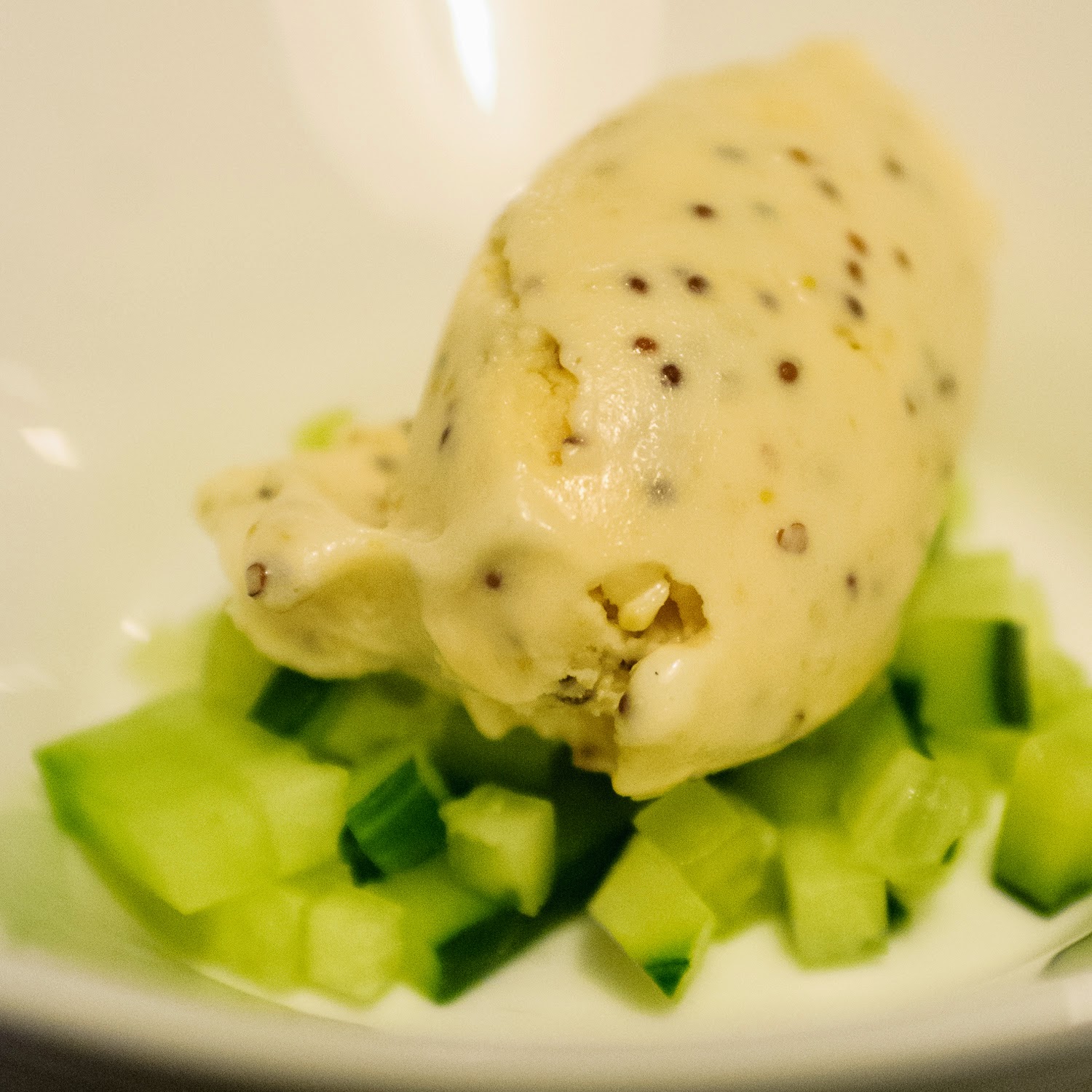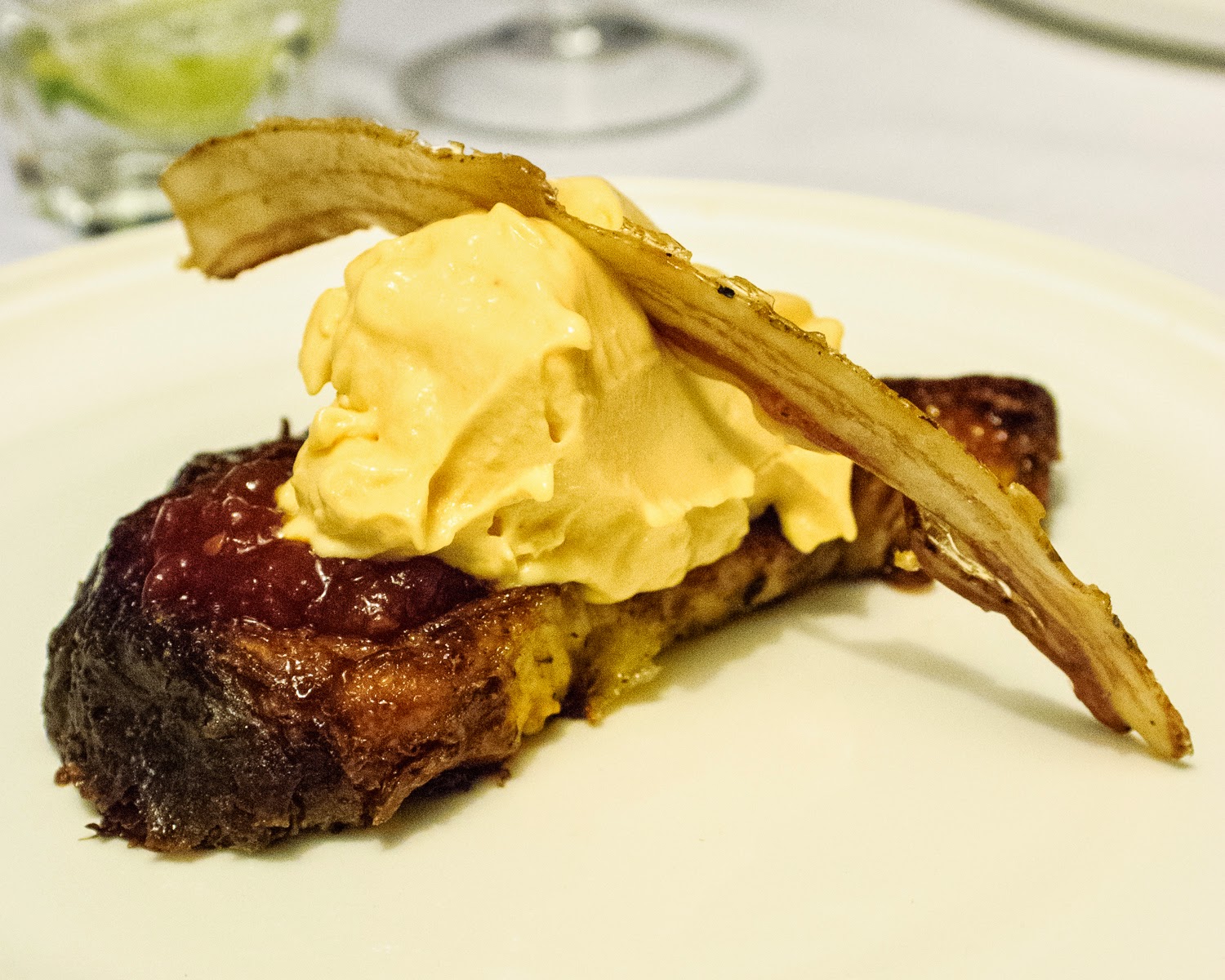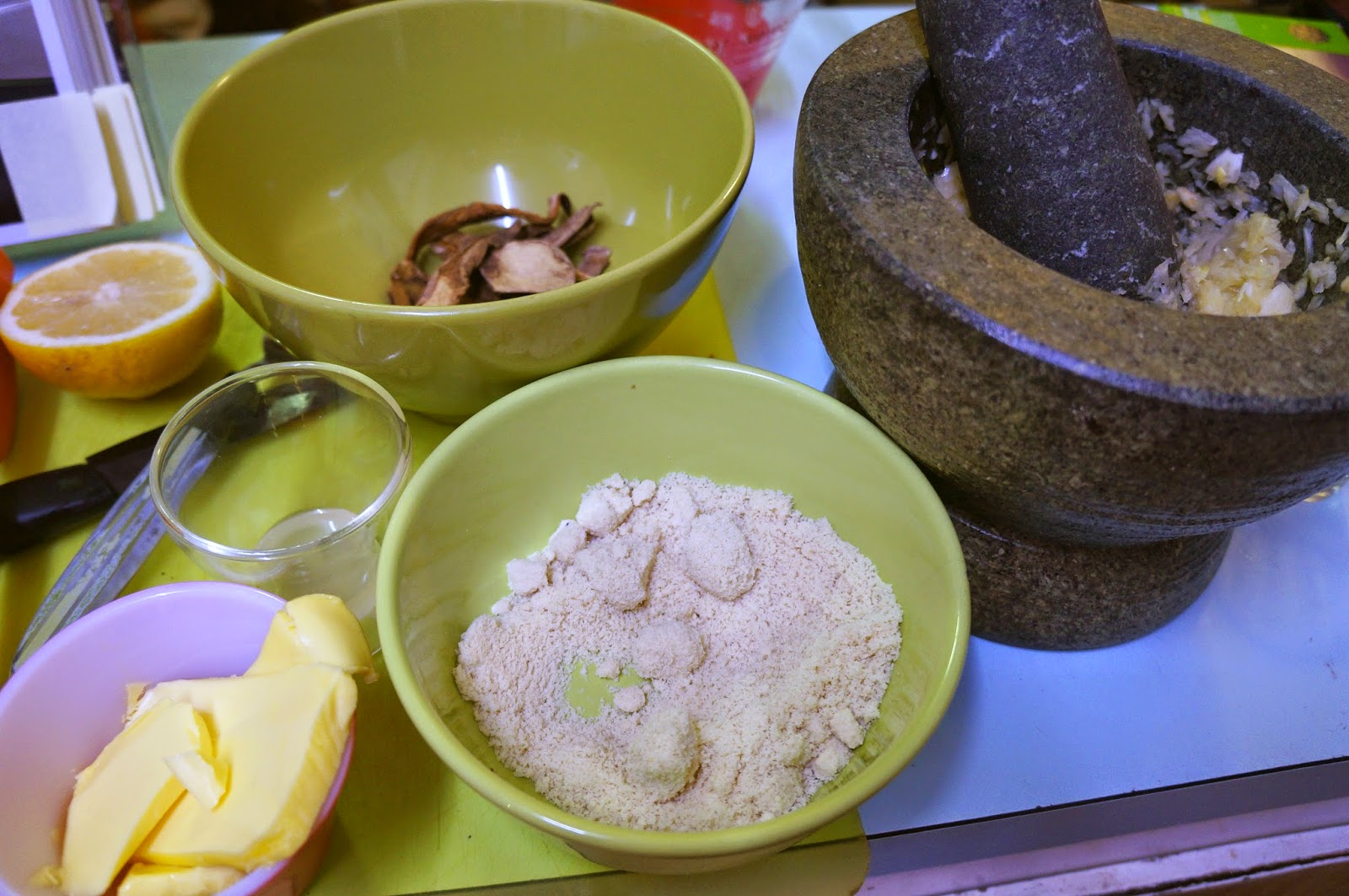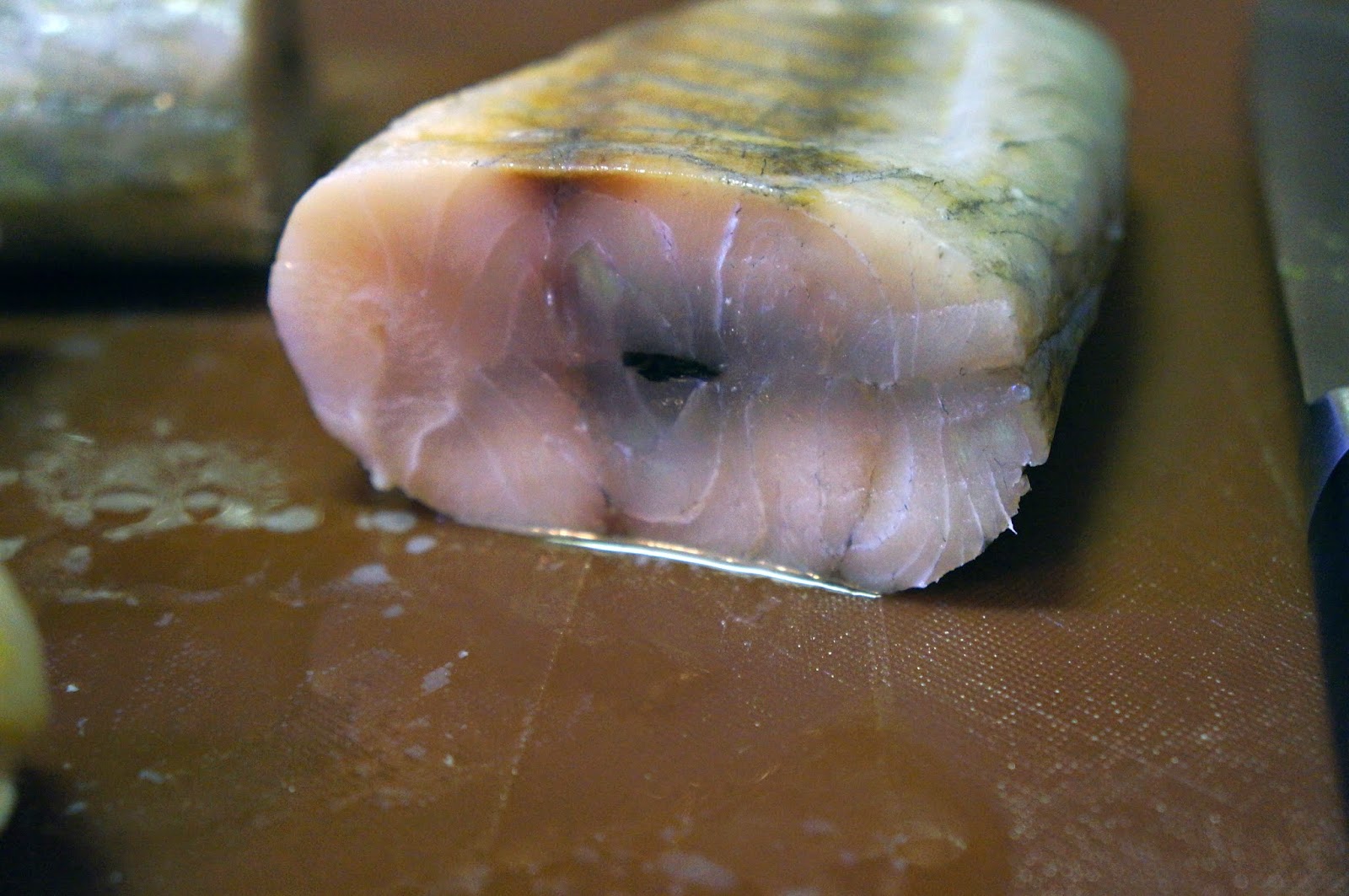Before I really knew much about Modernist cooking, I knew about Heston Blumenthal. Unaware of the pioneering (and arguably even more impressive) work of Ferran Adria and his peers, watching Heston's Feasts for the first time was a true eye opener. Fresh as I was out of art school when the first season aired, I saw someone working with food in a way that seemed closer in spirit to early 20th century Modern Art than any cooking that I'd seen before. Like the optimistic visual artists of the pre-war era, Heston's belief that anything was and still is possible was a comforting thought in an art world that to me at the time seemed jaded and cast adrift into a cycle of pastiche. And the fact all the new technologies, techniques and ingredients meant anything truly could be possible made it all the more impressive.
-----
When I heard that the Fat Duck was temporarily moving to Melbourne, I was ecstatic. I told my boss I was going to have to take a weekend away at some stage over that period, and decided to forego other events so we had enough money to afford travel and the meal. However, when the asking price was later announced at $525 - over $100 more than the same meal costs in Bray - and via a lottery system, my interest in dining at the Fat Duck in Melbourne seriously waned. Considering the expense of almost literally flying an entire restaurant over from England - brigade and all - the asking price was not totally unreasonable. However, for the $2000 we calculated the meal, flights and a conservative wine choice would cost, we could easily funnel that money into many more high end dinners during our Thailand, Japan and Hong Kong trip next year. The opportunity cost was just too great.
Although we had organised it months before, it seemed fitting then that October's Ministry of Gluttony at Home dinner was themed around iconic dishes from the Fat Duck; its not quite the same as eating Heston's food as cooked by his team, but its a decent enough consolation prize. We decided early on that we would fit in as many of Heston's most famous signature dishes into our 4 course (plus amuse bouche and petit fours) format as we could, as well as finally get out the dewar for dishes prepared with liquid nitrogen. Our guests for the evening were Lexi Rollins and Jarrad Marshall (whose birthday brought us to Neighbourhood Pizza earlier this year), Tamara Woolrych and Gregory Bruyer (who took all the stunning photographs of the finished dishes) and repeat MoG at Home diners Ben Basell and Hayley Bahr.
After a welcome drink of Beefeater 24 Gin and Tonic, we dived straight into the Modernist proceedings with Nitro Poached Lime Tea Mousse - the dish that traditionally begins a meal at the Fat Duck. Basically a lime and tea foam dispersed from a cream whipper and then 'poached' in liquid nitrogen, the result is reminiscent of a meringue, with a crunchy outer layer and a soft fluffy interior - except for the fact that the refreshing acidity of its flavour was matched by a refreshing coldness from the freezing process. Made at our prep table with our guests gathered around to watch, there were a lot of excited 'oohs!' and woahs!' as the foams were frozen in front of their eyes, but we were all even more impressed by how well they worked as a bright, acidic palate cleanser. The soft airiness of the foam encased in a frozen shell really makes this dish, and having made the liquid nitrogen-free version of this dish from Heston at Home, there really is no substitute for the real thing.
The Eleven Madison Park themed dinner from the month prior really opened my eyes to how good a gazpacho could be, and for the first course we decided to serve Red Cabbage Gazpacho with Mustard Ice Cream. The Mustard Ice Cream was served on a bed of cubed Cucumbers...
... with the bright purple Red Cabbage Gazpacho poured into the bowl at the table.
The results were spectacular. A lot is made of Heston's mad scientist persona and the 'craziness' of his ideas, but what struck me about this dish was how sensible and coherent the flavours were. Red cabbage and mustard really do work wonderfully together due to the mustard oil that is already part of red cabbage's flavour profile, and by serving the cabbage in chilled gazpacho form, the idea of a savoury ice cream no long seemed so far-fetched. The sharp vinegary acidity of the chilled gazpacho combined with the creaminess of the Mustard Ice Cream was appreciated by all our guests, as was the dish's vibrant purple colour. For those at home who have the Fat Duck cookbook but are a little daunted by the difficulty of some of the more elaborate recipes, the surprising easy and relatively straightforward nature of this dish makes it a perfect starting point.
Heston's infamous Snail Porridge may sound disgusting to those with a less adventurous palate, however this was easily the best dish of the night. The words 'snail' and 'porridge' seem like they really should not go together, but once you break the idea down it makes so much sense. The dish's strangeness comes from the breaking of two conventions - that porridge is a breakfast-only food, and that snail (in most English speaking countries at least) is more often seen as a garden pest than as food. Outside the Anglosphere however, Parsley and Escargot Risotto is a fairly conventional dish by French fine dining standards. The only major difference in this dish (and its ingenious masterstroke) is that the standard risotto rice has been replaced by porridge oats. The result is something that is similar but texturally different to a risotto, with a nice malty, oaty flavour that you simply wouldn't get from rice.
Additionally, Heston has clearly obsessed a lot about making this dish positively overflow with flavour, and there is a lot of classical French technique that is the backbone behind this dish. The oats are cooked in a most flavoursome Chicken Bouillon, rich in the aroma of the thyme that is steeped in the base broth. Even more impressive was the parsley butter - besides parsley and butter, there are tiny pieces of duck ham and porcini mushroom, and shallots that were slowly crisped on a low heat for 30 minutes and thus intensified in flavour. Garnishes on top included finely shaved fennel tossed through a walnut vinaigrette and slices of Jabugo Jamon, as well as the flavoursome, slow braised snails. This was seriously one of the most delicious dishes I've had the pleasure of eating and cooking. We may not have had a Pacojet to get the parsley as fine as Heston does and we did triple the serve of porridge to make it more suitable for a 4 course meal, however I think we pulled this off as faithfully as we could, and I was particularly proud of the job Alissa and I did with the plating.
For the main, I really wanted to serve Salmon Poached in Liquorice Gel, however the idea of picking apart a grapefruit cell by cell for 8 people really didn't appeal to me. Instead, I decided to serve Sole Veronique from the Fat Duck's old a la carte menu since its accompanying side dish was Heston's signature Triple Cooked Chips. I've made Triple Cooked Chips many times now, and it really is the best chips I've eaten; the interior is super fluffy while the outside is so crispy you can audibly hear a crack as you take a bite. What's more, the chips don't become soggy as you get to the bottom - even when cold, they remain impressively crispy. I have to admit I had to cheat a bit here and use the domestic instructions from Heston at Home as I don't own a chamber vacuum sealer, but the results have never failed to impress those who have tried them. For a dipping sauce, I decided to make the Cucumber Gel that forms the basis of the Cucumber Ketchup served at Dinner by Heston, taken from the Historic Heston book. With its vinegary flavour, the Cucumber Gel tastes like liquid pickles - I can imagine the gel being great in a hot dog.
While I was happy with the presentation of this dish, it was also a bit of a fail due to some rookie mistakes. Firstly, I selected this dish before really thinking about seasonal availability as well as regional limitations. Firstly, the dish uses transglutiminase (meat glue) to glue two pieces of fish together with black truffles buried within. This was easy enough to do and was a pretty cool trick, however by October truffles are well and truly out of season in Australia. I thankfully planned ahead and froze some truffles in August, however I don't think they were as strong in flavour as they would have been had they been fresh. The worst mistake however was the choice of fish I used to substitute for Sole. Realising that Dover Sole was going to be impossible to find in Australia, I looked online for substitutions. My first choices of Flounder or Dory were also difficult to source, so I went with my third choice - Barramundi. Unfortunately, while Barramundi probably works as a substitute in a dish where the fish is well and truly cooked all the way through, the use of a low temperature sous-vide cooking method meant the fish was only cooked to a medium rare, resulting in a rubbery and somewhat unpalatable fish that lacked Barramundi's nice flakiness when cooked through. In the end, I collected everyone's fish and put them in the deep fryer to cook them more thoroughly. The results were better if still not what I had wanted. Still this experience taught me an important lesson for future dinners - test out any meat substitutions before the day, especially when cooking sous-vide.
On the plus side, the accompanying components all worked very well. The Grape Fluid Gel, Dehydrated Grapes and Marinated Grapes all added a pleasing sweetness, while the Parsley Foam was light in body while being full of flavour. Best of all was the lattice of onion rings; fused together with a sugar syrup and then dehydrated, the sweetness of the sugar combined nicely with the pungency of the onion's flavour.
The second best dish of the night was another Heston classic - Nitro-Scrambled Egg and Bacon Ice Cream. A dish consisting of super eggy bacon infused Ice Cream, Candied Bacon (actually prosciutto), Tomato Jam and Pain Perdu (aka French Toast), this was the dish that revolutionised desserts in the 2000s, and the over-saturation of bacon desserts towards the end of the decade does not diminish how successful the salty-sweet-umami flavours work together in this dish. The eggy mixture that the Pain Perdu is soaked in is less sweet than most I've tried, with the sweetness added after the toast is brown by quickly tossing it through caramelised sugar. The Bacon and Egg Ice Cream uses an extreme amount of yolks in its Anglaise base, giving a really rich eggy flavour that is made even more intense due to the infusion of super smoky sweet cured bacon. By itself, the Ice Cream can be a bit too much, but with the bread, the Candied Bacon and the slightly piquant flavour of the Tomato Jam, it all came together for a balanced whole that was better than the sum of its parts. Having made the domestic version of this dish before, the addition of the tomato jam was definitely worthwhile, and using a dehydrator to finish the Candied Bacon resulted in strips that were much crispier than the method suggested in Heston at Home.
As with the Momofuku Ko and Eleven Madison Park-themed dinners that preceded it, a lot of prep work went into getting the components of these dishes ready. Thankfully, the recipes from the Fat Duck Cookbook proved easier to make than the diabolically complicated dishes in the Eleven Madison Park book, but it was not without its own challenges. One such challenge was making duck ham 20 days prior to the meal, as it needed time to dry and cure. Having a need for duck bones to make a stock for the November Attica-themed dinner, it worked out being much more economical for me to buy three whole ducks and butcher the bird myself, with the Marylands going towards making Confit Duck for Christmas.
The breasts were dry cured with salt and spices...
... and the next day were brushed, wrapped in muslin and hung. Heston suggested 'a cool place' for 20 days, however with Australia being much hotter than England we thought it was probably safer if we kept them in the fridge.
The result looked like this. It was a bit shy of 20 days, however it have a lovely, prosciutto-like flavour. With only 2 of the breasts required for the Parsley Butter, we ended up eating the rest as snacks and on sandwiches in the weeks after the meal.
A small but crucial component, as a preserve the Tomato Jam could also be made sometime in advance.
After being diced and macerated, the tomatoes were strained...
... put in a pan...
...and reduced. Notice the coffee beans, a touch I've seen in a few Heston dishes.
The result was jarred and ready to go.
The Triple Cooked Chips were cooked in hot water until they began to just fall apart, were cooled in the freezer and then fried at a moderate temperature...
... resulting in completion of the first two stages, ready for the final frying just before service.
For the Egg and Baon Ice Cream, smoky, sweet cured bacon was roasted in the oven...
... chopped up...
... and placed in milk overnight to infuse with flavour. Heston's bacon choices are difficult to source in Australia, however I found an excellent Maple Cured Bacon at Mondo Butchers that had the required sweetness and smokiness.
Over 24 yolks were used to give the Anglaise its intense egginess...
... with the final result mixed together earlier in the day, ready for the final Nitro-Scrambling. Heston injects this mixture into eggs that are broken at the table, however I opted to simply pour into a saucepan from a jug instead. Less theatrical I know, but injecting eggs seemed like a lot of work for not much of a pay-off at home.
The thinly sliced pancetta was bagged with the maple syrup...
... brushed with an additional sugar syrup and placed in a dehydrator.
The crispy results were far better than the method suggested in the Heston at Home book.
Ingredients for the Parsley Butter included lemon juice, butter, ceps (we used dry as its seemingly impossible to get fresh in Perth), almond meal, garlic...
... and of course heaps of parsley.
The resulting butter having an intense, multi-layered flavour.
Snails are very difficult to source in Australia, especially if you're not willing to settle for produce from a can. I eventually found a Snail Farm over east who put me in touch with their distributor in Perth - none other than Mondo Butchers. After helping me out with the Guanciale and the Lamb Sweetbreads for the Eleven Madison Park dinner and now the snails, Mondo are basically my go-to when it comes to unconventional meats. If only I could find a vegetable equivalent.
The recipe and the packaging the snails came in suggest really giving them a good wash, so I did.
Meanwhile herbs and aromatics were prepared for the braise.
Once warm, the snails were added in and braised on a low temperature in the oven.
A piece of bread was added to the juiced Red Cabbage to impart its proteins to the gazpacho. The recipe called for white bread, but only having a slice of multi-grain on hand meant a small and probably inconsequential substitution.
Being the avant-gardist that he is, cooking from the Fat Duck needs a lot of specialist ingredients, and one has to get familiar with the different types of Maltodextrin, the difference between Low and High Acyl Gellan Gum, and the reason why High Methoxyl Pectin might be required for a specific recipe. Even then, Heston actually called for DE19 Maltodextrin, but with no easy source for it in Australia, I went with the much more common DE18. The Melbourne Food Ingredient Depot are a good source for these kinds of specialist ingredients, and I'm starting to build up a collection of their stylish canisters.
Earlier in the year, I managed to purchase a 10 litre Liquid Nitrogen Dewar from an old high school friend who works in a lab. With Dry Ice much easier to come by and effective in smaller batches, it took this dinner for us to finally use the Dewar. Unfortunately, my first attempt at picking up the Liquid Nitrogen failed since BOC's Duty of Care prevents them from allowing the sale of liquid nitrogen if it is being transported in a car, even if the driver was aware of the risks and was going to drive with the windows down. Thankfully, Alissa's parents were visiting that weekend and were able to assist us by putting it in the back of their ute. Being much colder than Dry Ice, Liquid Nitrogen is more economical for ice cream making, and using a paddle attachment on our Kenwood produced a very rapidly frozen ice cream with a wonderfully professional consistency.
The use of Gellan was also a first. Compared to the Agar gels from the Eleven Madison Park dinner, the results were surprisingly coarse. Perhaps our blender isn't good enough, but I feel like I need to experiment more with Gellan to see why Heston is so enamoured with it.
Another first was the use of Transglutiminase, or Meat Glue.
The Sole Veronique recipe called for shavings of Black Truffle to be sandwiched in between two fused together pieces of fish.
After being wrapped in cling film for a few hours, the pieces were successfully joined...
... with the cross section revealing how the proteins of the fillets had been bound together.
Finally, though it may seem less intimidating than all chemical wizardry, getting the chocolate tempering right was probably the single task I was most worried about. Unfortunately, I simply did not have the time to make the chocolate using Heston's long winded method, so I had to fall back on the standard seeding method I'd seen many times on Masterchef.
I was happy when the chocolate came together with a nice sheen, and cut easily into need slices to be placed on top of the Millionaire Shortbread.
Cooking from the Fat Duck Cookbook was an excellent learning experience. As impressive as the scientific wizardry can be, what was even more impressive about the Fat Duck recipes was how delicious they were - regardless of the how fanciful or seemingly crazy his ideas may be, Heston never loses sight of the fact that food must, at the end of the day, taste good. Haters of Modernist Cooking really need to try some of these dishes before making the kind of blanket negative statements I've read in print and online. Except for the Sole Veronique itself, all the dishes we served are iconic and rightly famous works of contemporary gastronomy. This cookbook then is essential reading, however I have to admit that the fact the recipes don't tell you how many they are supposed to serve somewhat frustrating, and required me to decipher from the portions suggested per plate how much of each component was required. In most cases there is more than enough, but if I hadn't done the maths we would not have had enough Egg and Bacon Ice Cream to got around. With a bit of careful reading of the recipes and their proportions, these dishes are quite achievable - although there was a much higher use of specialist ingredients and equipment and chocolate tempering requires a good thermometer and some concentration, it was certainly easier and less stressful than the Eleven Madison Park dinner was.



















































Magnificent! My fav post to read of your at home dinners so far :)
ReplyDeleteI can see how Heston was probably one of the first chefs that inspired you and I hope you and Alissa get to eat at the real Fat Duck one day!
Have you ever read the blog The Big Fat Undertaking https://thebigfatundertaking.wordpress.com/ where a dude cooks through the whole Fat Duck cookbook and documents it?
Thanks Ai-Ling! I hope we'll get to Fat Duck one day, or at the very least Dinner by Heston :).
DeleteI have read the Big Fat Undertaking; his and Carol Blymire's Alinea and French Laundry blogs have been great inspirations and resources. My favourite part of the Big Fat Undertaking is how much trouble he has trying to get Hearts of Palm, as he mentions it many times throughout the blog before giving up when making the Vegetarian Pot au Feu!
I think the most impressive thing would be to see someone pull of Noma or Faviken without substitutions. That would be incredible.